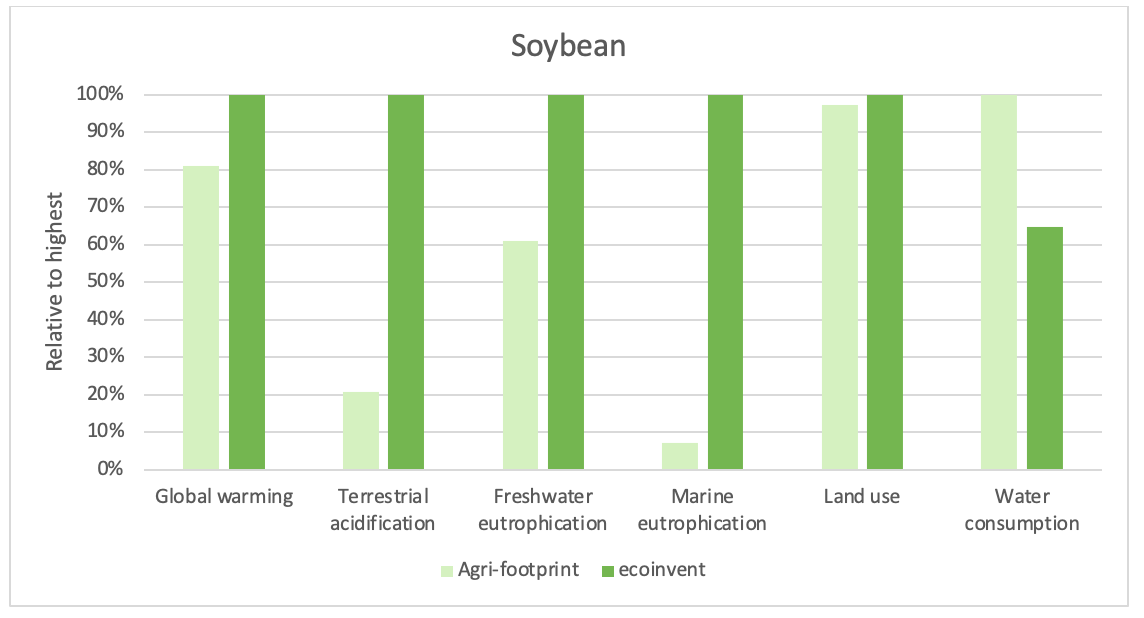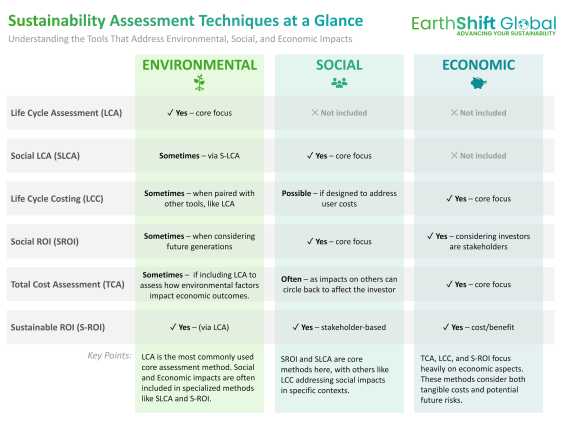June 2025 The Shift e-newsletter
Land Use Change Webinar | Ag Datasets | S-LCA | Upcoming Training
Free Webinar:
Land use change data in high resolution:
A gamechanger for more accurate LCAs
Date: June 26, 2025
Time: 1:00pm - 2:00pm ET
Presenters:
Simon Gmünder and Xavier Bengoa
Co-founders AdAstra Sustainability
Description:
New technology is transforming how we account for the impacts of land conversion in agricultural supply chains. Insights built in high resolution are now accessible to anyone through Orbae, an open-data platform of land use change emissions.
Land conversion makes up about 11% of global greenhouse gas emissions, most of which is driven by agricultural expansion. But many companies still face significant barriers to taking action.
Join Simon Gmünder and Xavier Bengoa — co-founders of AdAstra Sustainability and part of the team behind the Orbae platform — to hear about the solutions they’re developing to sidestep traceability hurdles and develop actionable insights that you can apply to your own work.
About AdAstra Sustainability
Founded in 2022 by three experts in quantitative sustainability, geospatial data science and food systems, AdAstra supports stakeholders along agricultural value chains in taking decisive action for operating within planetary boundaries.
Background Agricultural Datasets in LCA Studies:
Implications of Database Choice

Agriculture-based products are frequently used as main feedstocks in several sectors (e.g., food, biofuels, consumer goods, etc.).
The selection of background database, with their underlying differences in inventory data and modeling approaches, will have implications for the potential environmental impacts and their interpretation.
LCA practitioners model unit processes and systems based on both foreground and background data. Foreground data is related to the specific processes defined as the main points of interest for the study, while background data consists of both upstream and downstream processes related to the assessed system. In most cases, background data is modeled after external secondary sources, such as commercial LCA databases.
There are multiple commercial LCA databases whose set of listed datasets will depend on the geographical and sector scope of each database. Oftentimes, two or more LCA databases will include the same product system with a similar geographical and technological definition. In practice, LCA practitioners choose between datasets to input background data into their LCA models. This choice is particularly relevant for agricultural crops datasets because it is common for agriculture-based products, regardless of their location in the production chain, to show the upstream agricultural stage as one of their impact hotspots. Hence, the quantification of upstream impacts related to the agricultural stage will be essential to the product’s environmental performance.
What happens during the agricultural stage
Inputs such as fertilizers, pesticides, machines, seeds, and energy carriers are required to cultivate and harvest agricultural crops; these inputs all need to be present on or transported to the farm. In addition, some crops require direct irrigation.
Inputs transported to the farm will influence the crop’s ultimate growth and outputs. Moreover, the reactions between these external inputs and the soils in which the crops are being cultivated will cause diverse emissions to air, water, and soil, called direct field emissions. Fertilizers (whether synthetic or organic) are normally used to supply nutrients to the crops; the main nutrients are nitrogen (N), phosphorus (P), and potassium (K). The application of these nutrients will ultimately support the crop’s development but will also cause several direct field emissions: the use of N-containing fertilizers will cause emissions of ammonia (NH3), nitrous oxide (N2O), nitrogen oxides (NOx), and, in some cases, carbon dioxide (CO2) because of several volatilization, mineralization, nitrification, denitrification, and dissolution reactions between the applied nutrients and the soil biogeochemistry. Also, the application of fertilizers is closely related to leaching, erosion, and runoff of nitrates (NO3-) and phosphates (PO43-), as well as changes in the heavy metal balance of soils. Pesticide application (insecticides, herbicides, and fungicides) will similarly result in the release of toxic active ingredients into the environment. Additionally, the specific farming practices that take place in each system through the use of machinery and its operations will influence certain fertilizer and pesticide-related emissions, as well as demand their own fuel consumption.
How LCA captures the direct field emissions of agricultural systems
The LCA sector has developed robust science-based formulas, calculation procedures, and models to quantify the direct field emissions from a given agricultural system. Each LCA database has defined its main calculation rules and methods. In short, the main principle for these calculations consists of quantifying the net nutrient inputs after the total consumption of either synthetic or organic fertilizers or pesticide composition. Afterwards, each chemical substance's emissions are quantified by following its specific calculation formula, which may also require using parameters related to the physicochemical properties of the cultivation soil (e.g., precipitation, temperature, erosion, clay content, etc.).
Some of the existing main calculation procedures include (but are not limited to):
- Intergovernmental Panel on Climate Change (IPCC) 2006 and 2019 Guidelines for National Greenhouse Gas Inventories.
- European Environment Agency (EMEP-EEA) Air Pollutant Emission Inventory Guidebook.
- Sustainability Quick Check for Biofuels (SQCB).
- Swiss Agricultural Life Cycle Assessment Method (SALCA).
LCA databases do not use the same field emissions methodologies
Understanding this is crucial for an adequate interpretation of results and selection of background datasets. Each LCA database defines the specific field emissions calculation methods in use.
As an exploratory study, EarthShift Global compared the agricultural cultivation inventories and potential environmental impacts of two crops, Argentinian soybean and Philippine coconut, in two different LCA databases: ecoinvent 3.10 and Agri-footprint 6. To ensure a fair comparison, an economic allocation criterion was selected for the four compared systems in both databases.
This exploratory study had three main phases: 1) Analysis of main formulas for calculation methods, 2) Inventory comparison, and 3) Environmental impacts comparison (through the ReCiPe 2016 midpoint (H) impact assessment method).
Assessing Non-Environmental Aspects of Sustainability: SROI, S-ROI, TCA, SLCA
Life Cycle Assessment and GHG accounting are proven approaches to environmental assessment. But in the pursuit of triple bottom line sustainability, there are two other pillars that need to be considered on our journey to sustainability—the social and economic aspects of our choices. In this article, we explore several assessment techniques that examine social and economic choices, at times in conjunction with environmental assessment. These assessments include SROI, TCA, S-ROI, and SLCA.

Social scientists have long used case studies to understand the impacts of choices. These studies are similar to risk assessments and environmental impact assessments because they are site-specific and delve into one or more specific aspects of a choice. Case studies can be informed by on the spot interviews, behavioral observation, or other techniques.
More recently, Social Return on Investment or SROI has been considered as a way to uncover broader implications of our choices. In SROI, the researchers try to determine which stakeholders are affected by the choices and whether the impacts are material to the stakeholder. In most cases, the impacts are assessed monetarily, and since the investor is also a stakeholder, this monetary assessment also covers the economic pillar of sustainability. Some SROI’s include future generations and so may include the environmental pillar as well. The assessment is accomplished through a workshop, survey, interviews or a combination. Literature research is used to ensure the results are robust. Some of the principles of SROI are Involve Stakeholders, Measure what Matters, and Be Transparent.
Total Cost Assessment (TCA) was developed to understand the economic impacts of corporate environmental and safety investments. TCA considers the impacts to a single stakeholder—the company or investor, yet because the impacts affect other stakeholders and those stakeholders may in turn affect the investor, the result is often a multi-stakeholder assessment.
If assessing prior to the choice or investment, there is a high level of uncertainty about the effects on stakeholders. TCA adds the element of uncertainty to the assessment; including the uncertainty enables inclusion of very low probability but very high cost risks in the assessment. TCA includes five cost types: direct, indirect, contingent liabilities, intangibles and externalities. The data for a TCA typically come from a workshop. Because the economic data may be highly confidential, workshop participants are typically internal to the company and results are kept internally. Life Cycle Assessment is often a key part of TCA, including a monetization of the impacts.
How LCA Helps Manage Business Risk and Uncertainty

The headwinds pushing back on ESG and related initiatives seem to be growing stronger (or at least louder) everyday; the U.S. Securities and Exchange Commission just announced it has voted to end its legal defense of its climate disclosure rules, effectively walking away from its regulation requiring companies to report on climate risks and greenhouse gas emissions. This announcement joins others of a similar nature (the delay of EU CSRD implementation and the withdrawal of several big banks from the Net Zero Banking Alliance, for example).
The current situation creates risks and uncertainty - should organizations be considering a reduction in sustainability related efforts or should organizations stay the course?
At EarthShift Global, we have been focused on sustainability for almost three decades. In that time, we have seen sustainability terms evolve from corporate social responsibility (CSR) to the most recent environmental, social and governance (ESG). No matter the term, the underlying need for efforts to address environmental impacts has not diminished but grown ever more critical - it is impossible to honestly deny the scientific reality of the changing climate and its increasing risks to our planet and it inhabitants.
It is our belief that political headwinds will come and go, but the clear and present reality of a warming planet is here to stay.
Staying committed to environmental programs, especially in an uncertain business climate, is a strategic move that can offer long-term benefits.
And LCA is the strategic tool to help understand and manage risks and uncertainty.
Here's how:
Cost Savings & Efficiency
Sustainable practices often lead to cost reductions in energy, water, and waste management. Companies that invest in eco-friendly solutions tend to lower operating costs over time.
LCA goes beyond measuring environmental impact; it helps businesses identify inefficiencies, reduce waste, and optimize resource use. By analyzing the entire life cycle of a product or process, from raw material extraction to disposal, companies can uncover opportunities for cost savings, such as:
- Energy and Material Efficiency: Identifying areas to reduce energy consumption or switch to cost-effective, sustainable materials.
- Supply Chain Optimization: Finding alternative suppliers or processes that lower costs without compromising quality.
- Regulatory Preparedness: Staying ahead of evolving environmental standards, avoiding compliance-related fines or disruptions.
Even when sustainability funding fluctuates, companies that integrate LCA into their decision-making are better equipped to remain competitive, resilient, and “future-proof.”
Competitive Advantage & Brand Reputation
Consumers favor businesses with strong sustainability commitments and are not afraid to boycott brands that no longer fit their values or needs. Companies with green initiatives often attract more customers, build loyalty, and stand out in the market. Because brands are built over the long term, the brands that demonstrate consistent support for environmental and social concerns will out position their rivals who do not demonstrate the same level of commitment. Remaining committed to your sustainability efforts can be one of the best ways to leapfrog your competitors.
LCA builds trust because consumers trust brands with credible environmental data.
LCA provides scientifically backed insights that can be used for marketing and certifications. Many sustainability certifications (e.g., CarbonNeutral, EPDs) require LCA data, which can enhance brand reputation and marketability.
Upcoming Online Training
Introduction to Sustainability Assessment
June 17, 2025
Social Impact Assessment, Sustainability ROI
September 10-11, 2025
Advanced Life Cycle Assessment: Interpretation
November 5-6, 2025